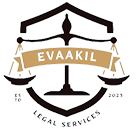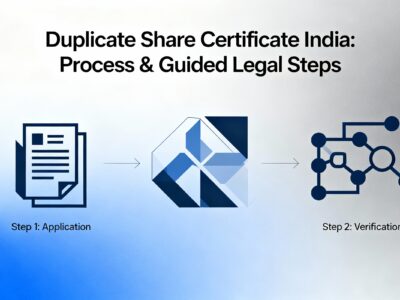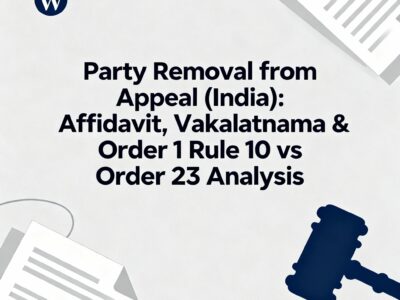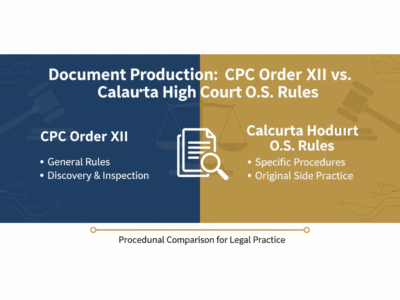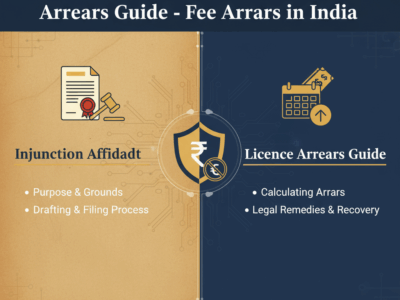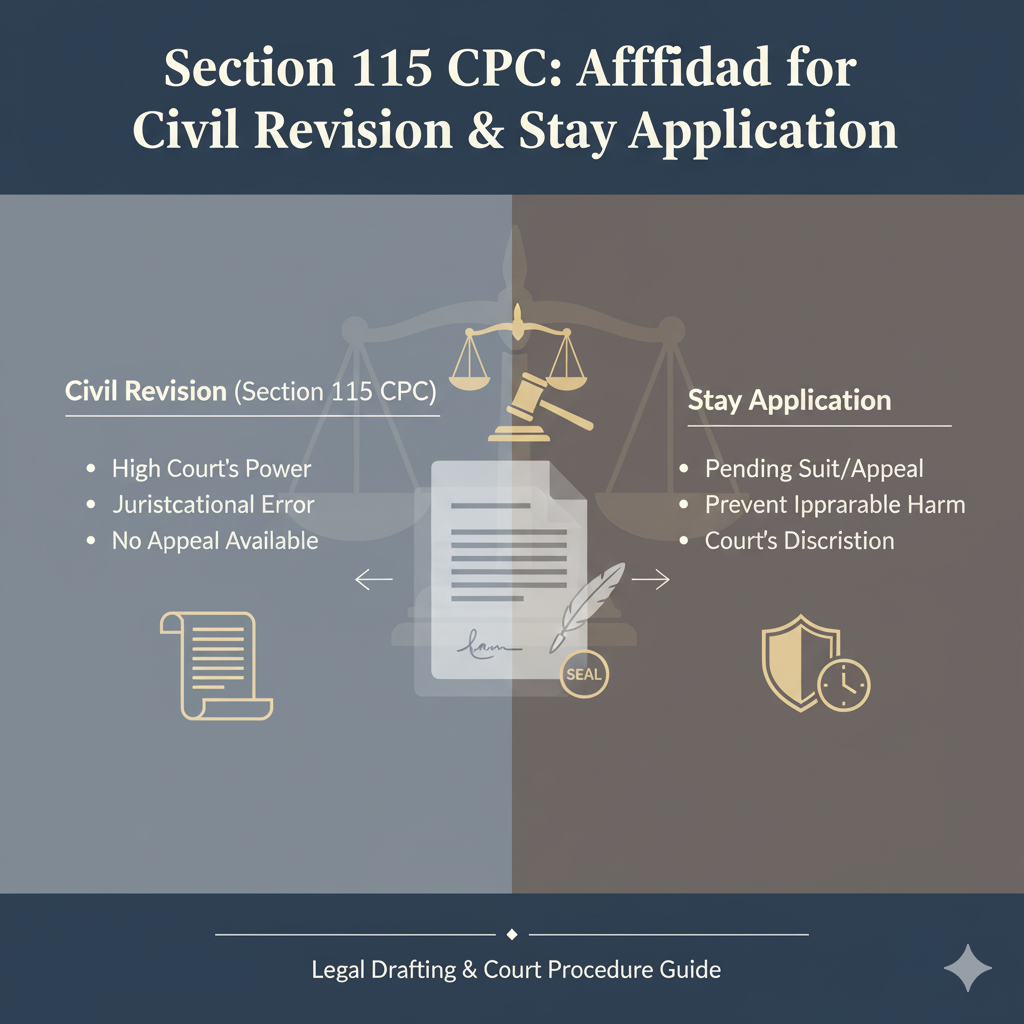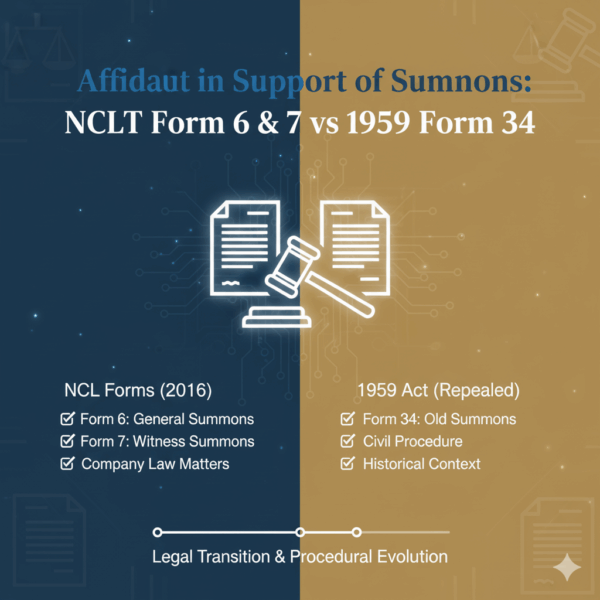Have you received a legal notice for a business you don’t own? Or discovered your PAN was misused to create a fake GST registration? Being wrongly linked to a company, proprietorship, or partnership can lead to serious legal and financial trouble.
This guide provides the solution: the Affidavit of Non-Ownership. We will walk you through the complete legal process, from drafting to submission. You’ll find free, targeted templates for banks, the GST department, and general use, along with an interactive guide to the correct stamp duty for your state.
Your Guide to the Affidavit of Non-Ownership
How to legally disconnect yourself from a business you do not own. A practical guide for Indian citizens.
What is an Affidavit of Non-Ownership?
An affidavit is a formal, written statement of fact. You swear it is true before an authorized official, like a Notary Public. This document is not a simple letter. Its power comes from the fact that you are under oath. Lying on an affidavit is a criminal offense.
An Affidavit of Non-Ownership is used to formally declare that you have no connection to a specific business. This is often necessary when a bank, tax department, or other authority wrongly links you to a company, perhaps due to a similar name, misused PAN card, or incorrect address.
Simple Letter
A plain letter stating your case. It is not sworn.
- Low credibility.
- Often ignored by authorities.
- No legal penalty for lying.
Notarized Affidavit
A formal statement sworn before a Notary Public.
- High credibility.
- Forces authorities to take action.
- Legal penalty for lying (Perjury).
Why Would You Need One? Common Scenarios
This issue is more common than many people think. You may need an affidavit if you find yourself in one of these situations:
PAN Card Misuse
This is the most frequent cause. Someone fraudulently uses your PAN to register for a GSTIN or open a bank account, linking you to a business you've never heard of.
Similar Names (Same Name)
A bank or authority confuses you with someone else who has the same name and is a defaulter. Your CIBIL score could be affected until you provide this legal clarification.
Identity Theft
Someone uses your stolen Aadhaar, PAN, and address proof to create a shell company for illegal activities, and you only find out when you receive a legal notice.
Informal Partnerships
You may have verbally agreed to help a friend start a business, but never formally joined. If they list you as a 'partner' on a document, you become liable for their debts.
Incorrect Address Linking
A previous tenant at your address may have registered a business there. Authorities may send notices to your address, assuming you are the new owner of that business.
Exiting a Business
You legally resigned as a director or partner, but the official records (like MCA or GST) were never updated. This affidavit supports your resignation documents.
How This Differs by Business Type
Your denial must be specific to the type of business you are being linked to. The templates above include specific clauses, but here is a clear breakdown of what you are denying for each entity type.
1. Proprietorship
This is a business run by one person. The business and the owner are legally the same.
- ➝ What you deny: "I am not the 'Proprietor'. I did not open the bank account, get the GST number, or obtain the Shop & Establishment license for this firm."
2. Partnership Firm
A business run by two or more partners. All partners have unlimited liability for the firm's debts.
- ➝ What you deny: "I am not a 'Partner'. I have not signed any Partnership Deed, and I am not listed as a partner on the firm's PAN card or bank account."
3. Pvt. Ltd. Company / LLP
A formal legal entity registered with the MCA. Liability is typically limited to the company.
- ➝ What you deny: "I am not a 'Director' or 'Shareholder'. I never signed Form DIR-2 (Consent to be Director) and my Digital Signature (DSC) was not used."
Interactive Stamp Duty Guide
An affidavit must be printed on non-judicial stamp paper. The value of this paper is set by the state government and changes often. Using the wrong value will make your affidavit invalid.
Please select a state to see the required stamp paper value.
Stamp Duty Comparison (in INR)
The 5-Step Process: From Drafting to Submission
Following the correct procedure is just as important as the content itself. Here is the exact, unchangeable process you must follow.
Draft the Affidavit
Using the templates provided, draft the affidavit on a plain paper. Fill in all details: your name, address, the alleged business name, etc. Be precise and truthful.
Purchase Stamp Paper
Go to a licensed stamp vendor or a sub-registrar's office. Purchase non-judicial stamp paper of the correct value for your state (see our guide above). You can also get it e-stamped in many states.
Print the Affidavit
Get your draft printed *directly* onto the non-judicial stamp paper. The first page must be the stamp paper itself. If it's longer than one page, the subsequent pages can be plain "ledger" or "bond" paper.
Visit a Notary Public
Take the printed affidavit and your original photo ID (Aadhaar or PAN) to a Notary Public. **Do not sign it yet.** You must sign it *in front of* the Notary.
Sign and Attest (Notarize)
The Notary will verify your identity, watch you sign the document, and then countersign and apply their official seal. The document is now legally valid. Make photocopies for your records before submitting the original.
Targeted Templates for Specific Authorities
A generic affidavit is good. A targeted one is better. Select the authority you are dealing with to see specific clauses you should include.
General Purpose Affidavit
This is a strong, all-purpose template that denies all forms of association. It is the best starting point if you are unsure.
AFFIDAVIT
(On Rs. XXX Non-Judicial Stamp Paper as applicable in your State)
BEFORE THE NOTARY PUBLIC AT [CITY]
I, [Your Full Name], son/daughter of [Father's Name], aged about [Your Age] years, Indian Inhabitant, residing at [Your Full Address], holding Aadhaar No. [XXXX XXXX XXXX] and PAN No. [XXXXXXXXXX], do hereby solemnly affirm and declare on oath as under:
1. That I am the Deponent herein and I am fully aware of the facts deposed below.
2. That I have been made aware of an allegation that I am the owner/partner/proprietor of a business named "M/s [Alleged Business Name]" located at [Alleged Business Address].
3. That I categorically and unequivocally deny any and all association with the said Alleged Business.
4. That I am not the owner, proprietor, partner, director, or in any other way, financially, managerially, or legally associated with "M/s [Alleged Business Name]".
5. That I have no financial interest or stake in the Alleged Business, nor have I signed any document to establish or operate the same.
6. (Optional: If you know the real owner) That to the best of my knowledge, the said business is operated by Mr./Ms. [Actual Owner's Name]. I am attaching a supporting affidavit from them as ANNEXURE A.
7. That this affidavit is being made to be produced before [Name of the Authority, e.g., The Bank Manager, XYZ Bank] to formally place on record my non-association with the Alleged Business and to request that all records be rectified.
8. That all statements made above are true and correct to the best of my knowledge and belief.
DEPONENT
(Your Signature)
VERIFICATION
Verified at [City] on this [Date] day of [Month], [Year], that the contents of the above affidavit are true and correct. Nothing material has been concealed.
DEPONENT
(Your Signature)
(Attestation by Notary Public)
Sworn and signed before me on this day...
(Notary Seal and Signature)
For GST / Tax Department (PAN Misuse)
Use these clauses if your PAN was used to create a fake GST registration without your knowledge.
(Include these clauses in your main affidavit)
...
3. That my Permanent Account Number (PAN) [XXXXXXXXXX] has been used to obtain GST Registration No. [Fraudulent GSTIN] for the business "M/s [Fraudulent Firm]" without my knowledge, consent, or authorization.
4. That I have never signed any application, digital or physical, nor have I completed any Aadhaar authentication for the purpose of obtaining the said GST registration.
5. That I am annexing a screenshot from the official GST Portal's 'Search by PAN' utility, which lists the fraudulent registration, as ANNEXURE B.
...
For a Bank or Financial Institution
Use these clauses if a bank links you to a defaulting company or a fraudulent loan.
(Include these clauses in your main affidavit)
...
4. That I am not a signatory, guarantor, promoter, or beneficiary of any loan, credit facility, or bank account held by "M/s [Alleged Business Name]" with [Name of Bank] or any other financial institution.
5. That I have not executed any personal guarantee, indemnity bond, or board resolution on behalf of the Alleged Business.
...
For Ministry of Corporate Affairs (MCA)
Use these clauses if you are falsely named as a Director in a company (Pvt Ltd or LLP).
(Include these clauses in your main affidavit)
...
3. That I have been wrongly named as a Director in the company [Company Name] (CIN: [Company CIN]).
4. That I have never provided my Director Identification Number (DIN), nor have I signed Form DIR-2 (Consent to Act as a Director) or any other document for this appointment.
5. That I have no knowledge of the operations or statutory filings of the said company and am not liable for any of-its actions.
...
The Most Important Proof: The "Annexure A"
Your denial is strong. But it becomes almost undeniable if you can get the *actual owner* to sign an affidavit admitting ownership. This supporting document, called "Annexure A", should be notarized separately and attached to your main affidavit.
AFFIDAVIT (AS ANNEXURE A)
(On Rs. XXX Non-Judicial Stamp Paper)
BEFORE THE NOTARY PUBLIC AT [CITY]
I, [Actual Owner's Full Name], son of [...], resident of [...], do hereby solemnly affirm and declare on oath:
1. That I am the sole proprietor/partner of the firm M/s [Alleged Business Name] located at [Business Address].
2. That I am aware of an affidavit sworn by Mr./Ms. [Your Name] denying ownership of my business.
3. That I confirm and state that I am the sole and legal owner of the said business and am responsible for all its operations and liabilities.
4. I further confirm that Mr./Ms. [Your Name] has no right, title, interest, or involvement, financial or otherwise, in my business.
5. That this affidavit is being made to confirm the facts and to absolve Mr./Ms. [Your Name] of any association with my business.
DEPONENT
(Actual Owner's Signature)
VERIFICATION...
(Attestation by Notary Public...)
Before You Draft: Find the Facts
You can gather public data to support your case. This information can be attached as further Annexures (Annexure B, C, etc.).
- Check the MCA Portal: For Private Limited companies or LLPs, search the Ministry of Corporate Affairs (MCA) website. You can find the real directors' names and addresses.
- Check the GST Portal: Use the "Search Taxpayer" function on the GST portal. You can search by PAN (to see if fake registrations are on your PAN) or by business name.
- Check Local Records: For proprietorships, check your state's municipal "Shop & Establishment" license database.
A Warning: The Cost of a False Statement
This document is powerful because it is legally binding. Submitting a false affidavit is a serious criminal offense under the Indian Penal Code (IPC).
Indian Penal Code, Section 193: Punishment for False Evidence
In a Judicial Proceeding:
Up to 7 Years Prison
(If submitted to a court or tribunal)
In Any Other Case:
Up to 3 Years Prison
(If submitted to a bank, tax dept, etc.)
This is why a *truthful* affidavit is your strongest legal shield. It forces the other party to take your claim seriously.
What to Do *After* Submitting Your Affidavit
Submitting the document is not the final step. You must ensure it is acted upon.
- Get an Acknowledgement: When you submit the original affidavit, always get a "Receiving" stamp and signature on a photocopy. This is your proof of submission. If submitting by post, use Registered Post A.D. (Acknowledgement Due).
- File a Police Complaint (FIR): In serious cases, especially involving PAN misuse or identity theft for fraudulent loans, you must file a complaint (FIR) with the local police or the cyber-crime cell. Attach a copy of your affidavit to the complaint.
- Follow Up in Writing: If the authority (e.g., the bank) does not respond within 7-10 working days, send a formal follow-up letter or email. In your follow-up, refer to the submission date of your affidavit.
- Escalate if Ignored: If the local branch or office ignores your affidavit, escalate the matter to their nodal officer, regional head, or an ombudsman (e.g., the RBI Ombudsman for bank issues, the GST Council for tax issues).
Frequently Asked Questions (FAQ)
What is the total cost of an affidavit?
There are two costs: 1. The Non-Judicial Stamp Paper (which varies by state, see the chart above). 2. The Notary's attestation fee, which is typically a nominal fee (e.g., Rs. 50 to Rs. 200) for signing and sealing the document.
Can I just email or post this document?
No. The most important part of the process is the "attestation". You must be physically present before the Notary Public. You must sign the document in their presence, and they must verify your identity (usually with your Aadhaar or PAN card).
What if I do not know who the real owner is?
That is common. In this case, you simply delete paragraph 6 from the general template. Your affidavit is still a valid denial. The "Annexure A" from the real owner is helpful proof, but it is not mandatory for your own affidavit to be valid.
What is an "Annexure"?
An annexure is any supporting document you attach to your main affidavit. This could be the supporting affidavit from the real owner (Annexure A), a copy of your PAN card (Annexure B), a screenshot from the GST portal (Annexure C), and so on. You must refer to each one by name in your main affidavit.
